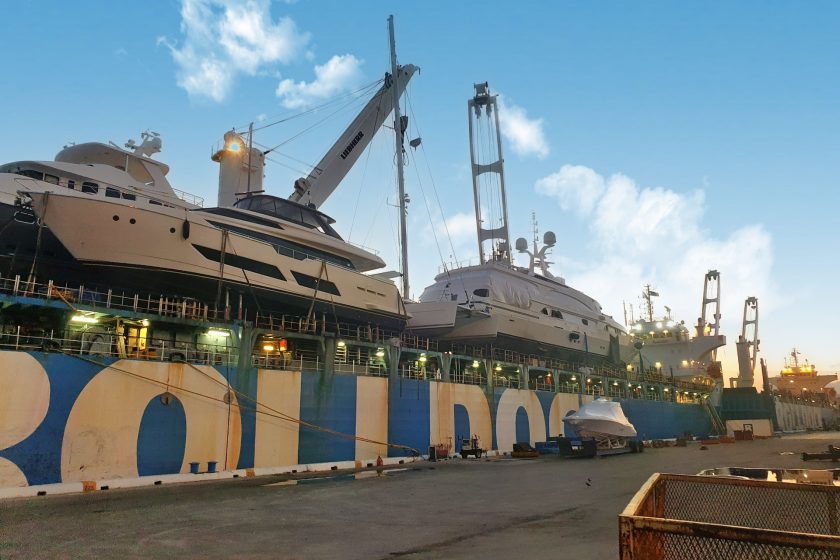One of the most common questions our team receives from our customers is, “How will my yacht be transported?” Our customers typically have two popular options: charter or liner transport. Both options have unique benefits, but understanding the key differences can save you time, money, and peace of mind. In this guide, we’ll break down these transport services, highlighting their similarities and differences to help you make the best decision for your yacht’s journey.
What is Charter Yacht Transport?
Charter yacht transport is a service that puts you in the captain’s seat, allowing you to schedule your transport based on your specific needs. With charter transport, you essentially “charter” or book an entire vessel dedicated to transporting your yacht, giving you a sense of control and personalization.
The main benefits of charter yacht transport are:
- Customization. Charter yacht transport allows you to design the route and schedule that best fits your itinerary.
- Flexibility. Charter transport lets yacht owners set the pace, allowing them to control the schedule to one that fits them and providing flexibility for last-minute plans or urgent situations.
- Customized service. Charter yacht transport is ideal for owners who need to transport their yacht to a specific destination or under tight time constraints. It’s also a great solution if your yacht requires special handling due to its size or type or if you’re moving to a less common route.
What is Liner Yacht Transport?
Liner yacht transport operates similarly to a traditional commercial shipping service. In liner yacht transport, yachts are transported along established routes on vessels that follow fixed schedules. There are several types of liner transport options available, and each has different pricing and suitability based on the yacht’s size and the service provided:
- RO/RO (Roll-On/Roll-Off): Yachts are driven onto the vessel and secured for transport. This option is generally more cost-effective for large yachts that can be rolled onto the transport ship.
- Containerized: Smaller yachts can be transported in containers, offering extra protection and reduced handling. This is often the best option for smaller yachts and offers a higher level of security.
- Out of Gauge: This service is used when yachts exceed the dimensions of a standard container. Yachts are loaded onto specialized equipment that can handle the additional size.
- Breakbulk: For large yachts that cannot be containerized, breakbulk shipping offers an alternative where the yacht is lifted directly onto the ship and transported as an individual unit.
- LCL (Less than Container Load): When the yacht does not occupy an entire container, it can be transported with other cargo to optimize space and reduce costs.
The rates for these options vary depending on the size of the yacht and the service available. Since liner services transport multiple yachts simultaneously, the costs are shared, making this a more budget-friendly option than charter services.
Comparing Yacht Transport Costs: Charter vs. Liner
On average, transporting a yacht within the U.S. costs between $1,500 and $100,000, depending on the yacht’s size, specifications, and transport method. Due to the Jones Act, there is no liner service available for domestic routes within the U.S. For short distances under 100 miles via trucking, you should expect to pay at least $2,000. As distances increase, so does the price.
However, regardless of the distance, charter transport is always more expensive because of its personalized nature. You’re paying for flexibility, custom scheduling, and potentially direct routes in charter yacht transport.
In addition to the transport method, distance, and yacht size, seasonality is another important factor. Costs (for both charter and liner) will likely be higher during peak boating season due to the higher demand and lower supply of transport vessels.
Flexibility and Convenience
Charter yacht transport provides the most flexibility and convenience in exchange for a higher price tag.
Charter transport offers the most flexibility regarding departure dates, customized routes, and arrivals, allowing owners to reach their destinations within tight deadlines. This option provides more control over the scheduling and route, making it ideal for those with more complex transport needs.
On the other hand, liner yacht transport provides significantly less flexibility for departures, routes, and arrivals since these services operate on regular intervals and along established routes.
If you don’t have to get your yacht to its destination on a tight deadline, liner transport is more cost-effective for you while providing the same core service.
Speed and Availability
Charter transport is always faster due to its on-demand nature. You can book a charter transport service exactly when you need it, allowing for a faster delivery time. However, availability depends on the season, and securing a charter vessel may require booking in advance during peak times.
On the other hand, liner transport availability depends on the carrier’s schedule, meaning you need to plan your yacht transport around it. While liners run regularly, they may be unable to accommodate urgent requests.
Safety and Reliability
Safety is a top priority for both charter and liner transport services, providing you with the reassurance and confidence in the security of your yachts. Whether it’s the personalized safety protocols of charter services or the industry-standard safety protocols of liner transport, your yacht’s safety is always a top concern.
Charter vs Liner Yacht Transport: Which One Should You Choose?
Now that we’ve explored some of the similarities and differences between charter and liner yacht transport, it’s time to tie it all together and determine which one is best for you. These are the main factors to consider when deciding between charter and liner yacht transport:
- Charter transport is more flexible in terms of departure dates, routes taken along the way, and arrival dates. Liner transport operates based on regular departure and arrival dates and established routes.
- Safety standards are essential in both charter and liner transport, but charter transport provides more customization while liner transport establishes the same security protocols for all vessels being moved in any given trip.
In summary, the decision between charter and liner yacht transport comes down to your budget, your timeline, and how much control you want over the process. If you have the budget and need to move your yacht to its destination by a specific date, charter transport may be the best option for you. However, if you’re more concerned about cost and can be flexible with your timeline, liner transport could be the way to go.
On the other hand, if you want a more cost-effective method in exchange for less control over the entire process, liner transport is the best option.
If you’re interested in moving your yacht but don’t know how or are unsure about the best method for your needs, you can contact us or get a free online quote. Our representatives will help you find the best option for your yacht’s needs.



